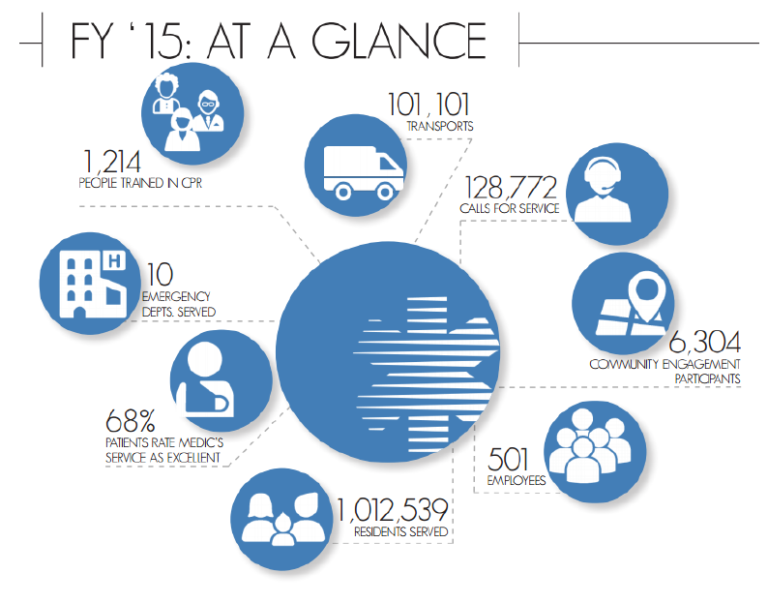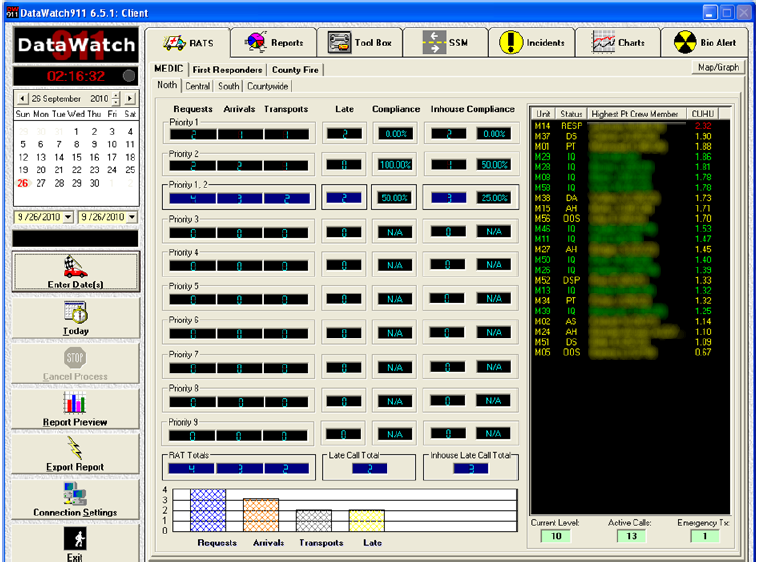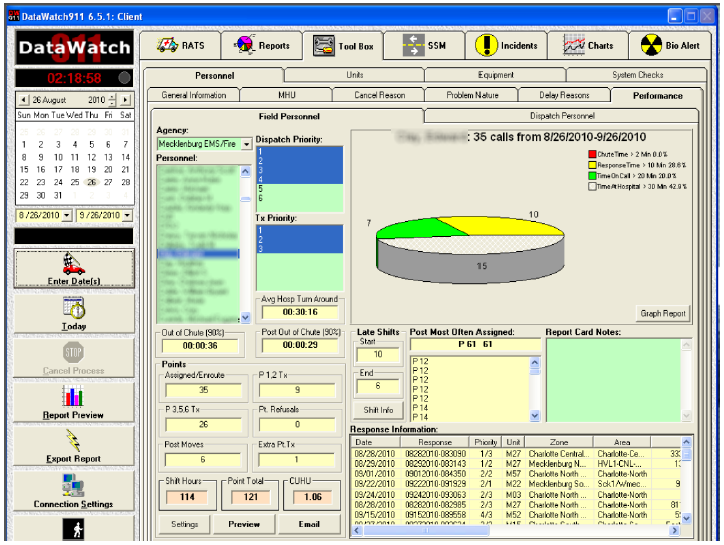Medic — the Mecklenburg EMS Agency
Medic operates the busiest 9-1-1 Emergency Medical Services (EMS) agency in the state of North Carolina. Contrary to popular belief, Medic is more than just an ambulance service. From SWAT, medical research and the latest in prehospital medical training and equipment, Medic is among the nation’s top 1% of EMS agencies in terms of positive outcomes for Cardiac Arrest victims.
Independently operated under Mecklenburg County, Medic’s responsibilities span 544 square miles. Mecklenburg County is a diverse and exciting environment with several professional sporting venues, multiple college campuses and universities, two major lakes, a busy international airport, several major business centers and corporations, two nuclear power plants and a population over 1,000,000 people.1

Using DataWatch911
Todd Sims,
Crew UHU (CUHU)
CUHU is a DataWatch911 unique feature used by Medic to rate the types of assignments a unit may be required to perform (i.e., transports, post moves, response to calls that do not result in transport, etc.). Point values are assigned to each type of assignment, the points are added for the assignments run and then divided by the hours on duty. Monitored assignments and point values are determined by a work team comprised of front line field personnel.
CUHU is calculated in real-time as work is completed. The crew with the highest workload at any given time is the busiest and working the hardest as defined by employees actually performing the work. As a result, CUHU can be used to compare availability and readiness level of crews for any given period of time.
Workload Management Implementation
To implement real-time workload management Medic went through the following process:
- Defining “work”
“Mecklenburg EMS Agency has relied on DataWatch911 for many years. It is a vital component of our dispatch operations which has helped us manage systems-wide productivity and accountability. It monitors total system performance, all compliance factors, and all customized workload metrics in real-time.” Todd Sims, Operations Manager Medic (Mecklenburg EMS Agency) 3 Medic, in conjunction with front line field personnel, defined work as activities carried out by the ambulance crews. As a dynamically deployed agency, this included post moves as well as transports and responses to calls that do not result in a transport. - Assigning point values to “work”
Medic worked with their crews to assign a point value to each assignment. Post moves,
responses, transports based on priority, and non-transports were all ranked and given a
point value. - Using CUHU for feedback to personnel
The culmination was a CUHU that could be used to give a meaningful relative value for the
workload of each crew and individual in real time, as well as cumulative for analytics.
Using CUHU for Feedback to Personnel
Medic implemented a robust performance management system — one that would improve its performance without disrupting existing workflows and aid them in gaining optimal coverage through effective deployment of its assets and crew members.
Background: Medic takes great pride in the transparency it offers to its employees in terms of performance and workload data. It ensures that employees are treated fairly and equally. Its management team has historically gone to great lengths to ensure that employee performance is reviewed objectively for the sole sake of improving performance, competency, and services.
Todd Sims,
DataWatch911 was integrated with Medic’s Computer Aided Dispatch (CAD) system, enabling Medic to directly mine CAD data for “in service” units and deployed assets as well as individual employees. The software was meant to aid Medic achieve two goals:
- Monitor In-Service Unit workload
- Monitor Individual Employee workload
In-Service Unit Workload: With configured work items and point values, DataWatch911 calculates CUHU. DataWatch911 uses the CUHU values to provide a relative value of how busy and effective a particular crew member has been.


DataWatch911 provides dispatchers with a prioritized list for crews as seen in the Requests, Arrivals, Transports (RATs) with Dispatcher Console. The calculated CUHU for each crew is presented in the Dispatcher Console on the right. Each crew member is assigned a CUHU and if multiple crewmembers on the same unit have different CUHU totals, DataWatch911 provides the higher value to the dispatcher console.
The highest CUHU for each unit is displayed on the dispatcher’s console allowing the dispatcher to determine which unit should be deployed for a non-emergent response or post move. For emergency response, the nearest available ambulance is always deployed
Individual Employee Monitoring
Medic currently employs over 500 employees, a majority of which includes EMD’s, EMT’s, and Paramedics. Efficiently tracking individual employee performance on a regular basis is critical to ensuring robust system performance.
Given the hectic dynamic nature of the work and Medic’s commitment to improving EMS care, retention of its employees (and their institutional knowledge) is crucial to Medic’s mission.
Meaningful and actionable insights into individual employee performance that enable proper feedback and mentoring is crucial to employee retention, while also improving agency performance. DataWatch911 provided the tools to allow Medic to effectively track individual employee performance on parameters unique to the organization and its performance management system.
Corinne Walser,
Although, Medic initially required measurement of two core metrics, namely:
- Average “out of chute” times
- Average hospital turnaround times
DataWatch911 also allowed them to track (for any determined period)
- Individual employee workload
- Historic data for post-assignments the employee has had during the specified period
- Number of late shift starts and late end of shifts including time total time of each
- Number of particular type of call any employee has completed within that period
Additionally, DataWatch911’s customizable dashboard allowed Medic to gain other relevant employee performance information at a glance in real-time.


Conclusion
The emergency response sector is in need of sophisticated 911-system management software that empowers EMS to track, monitor, and respond to incidents in real-time.
Medic – an EMS provider serving over 1,000,000 people, needed a powerful, responsive, and flexible solution for meeting the growing EMS challenges it faced as it scaled its services and service areas. The organization needed to reduce its response time, be able to effectively allocate staff and resources, gauge performance in real-time, and increase accountability.
As a dynamic EMS service where units are deployed to areas analyzed in real-time to have the most need, Medic required a way to fairly manage the process of system coverage while balancing employee satisfaction. Employees found post moves to be of great concern, so excessive or continuous post moves for any given crew needed to be accounted for in the workload calculation. 7
Michael J.
Medic used DataWatch911 to address operational quality assurance and optimize workload management practices. DataWatch911 directly interfaced to Medic’s CAD system, allowing Medic to improve the effective use of its first responder crews. DataWatch911 combined powerful EMS analytics and reporting tools that work-in real-time and include historic data to provide actionable insights for resource management and system level performance improvement to Medic. As a result, Medic was able to significantly improve its EMS operations.

